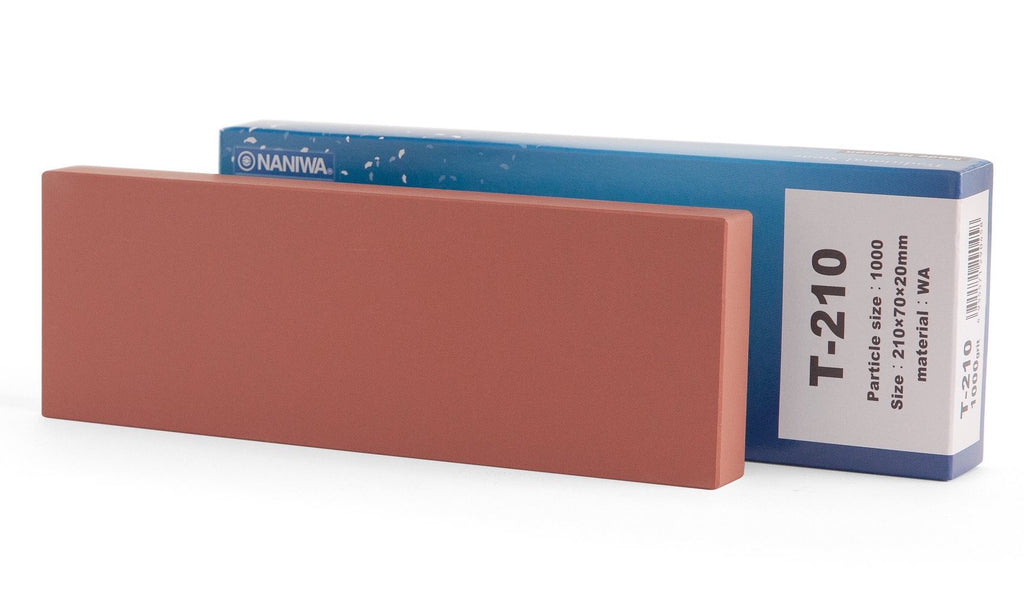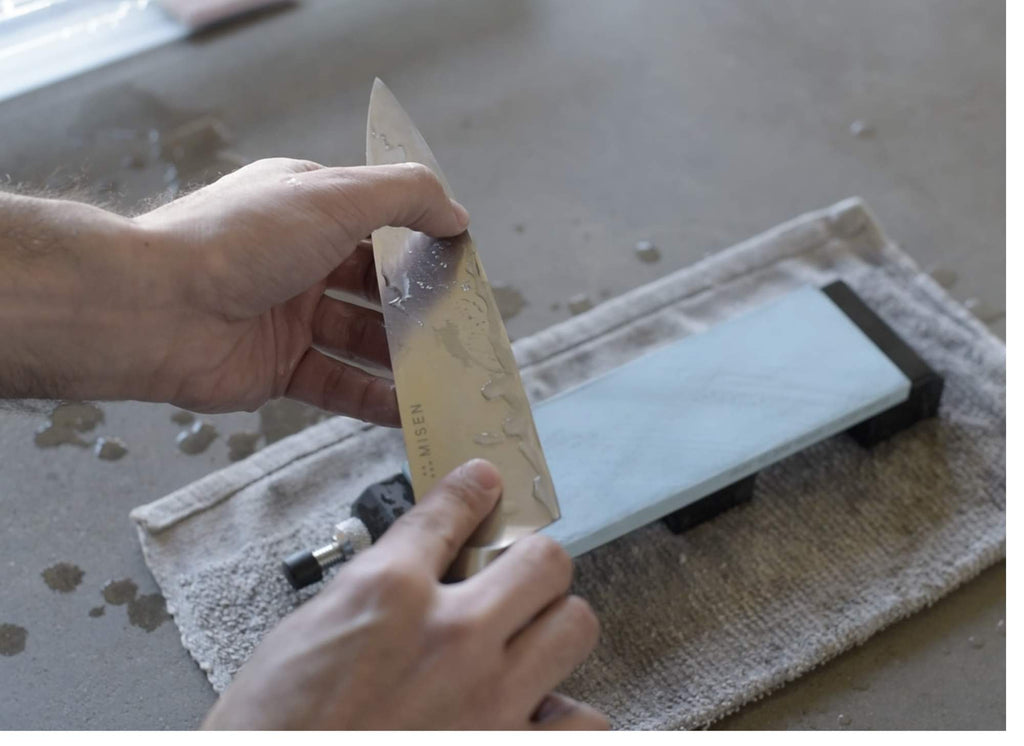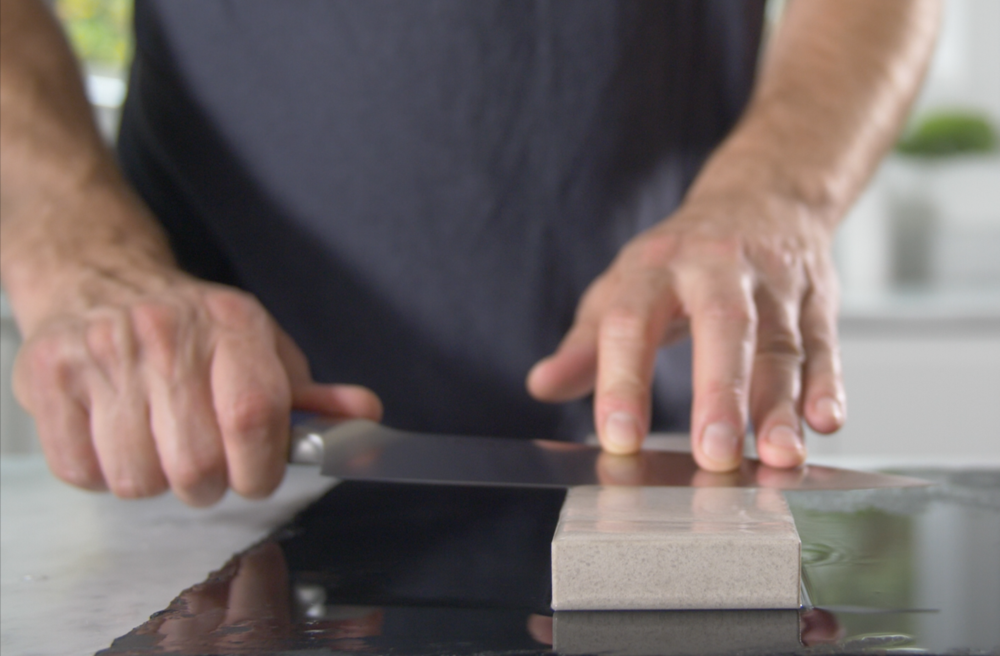Japanese Water Stones: The Time-Tested Knife Sharpening Tool
 Japanese water stones are softer than other whetstones, which allows them to quickly create a sharp cutting edge.
Japanese water stones are softer than other whetstones, which allows them to quickly create a sharp cutting edge.
- Water stones are a tried-and-true tool used to repair, sharpen, and polish kitchen knives.
- There are different types of whetstones — natural and synthetic, oil- and water-based.
- All whetstones must be thoroughly cleaned and dried before storage, and flattened after every few sharpening sessions.
Water stones, also called whetstones or sharpening stones, have a very practical, very scattered history. As the original blade sharpening tool, stones were something readily available and easily cut into any shape and size.
The best stone quarries were spread all around the globe — in Arkansas, Belgium, and Japan. Arkansas is noted for novaculite (also called Arkansas stone), a hard and dense rock mostly composed of silica. The Ardennes in Belgium is known for its Belgian blue and coticule, both a grey-yellow volcanic ash with garnet crystals and clay.
Japan stood out for its fine grain silicate and clay composite, primarily sourced from the Narutaki district north of Kyoto. The comparatively soft material made Japanese water stones much gentler on knives.
To this day, Japanese water stones are still one of the best tools to keep your cutlery in top shape. Read on to learn what makes a Japanese water stone so effective and how to find and use the best one for you.
Features of Japanese Water Stones
These days, Japanese water stones come in both natural and synthetic materials.
Natural Japanese water stones, like most whetstones, are cut from sedimentary rocks. The quarries in Japan, however, contained rocks with a unique composition — fine silicate grains embedded in a clay-like material, which made softer water stones.
Japanese water stones are also very porous and need to be soaked in water before use. As each natural water stone is different, the total soaking time can be anywhere from 30 minutes to over 24 hours — however long it takes for the stone to stop releasing air bubbles.
Soaking effectively fills the pores with water, creating a smooth surface to sharpen the blade. It also helps prevent debris from going into the stone and makes cleanup much easier.
Centuries of mining, however, have exhausted many of Japan’s quarries and made natural Japanese water stones hard to come by. The scarcity led to the development of synthetic Japanese water stones, usually made from silicon carbide (carborundum) or aluminum oxide (corundum).
Synthetic alternatives offer a consistent particle size and density, and can even be manufactured according to specific grits. Today’s synthetic water stones are not only equal in quality to natural stones, they are also more affordable and readily available.
Japanese water stones come in different grades. Usually numbered anywhere from 100 to 30,000, greater numbers indicate higher densities and finer particles.
For general purposes a 120-400 grit is used to grind out chipped or damaged knives, a 700-2,000 grit is enough for regular sharpening, and a 3,000-12,000 grit will give the blade a final polish.
Japanese Water Stones vs. Other Whetstones
 Whetstones will create a slurry, or paste of particles and liquid, that help further sharpen and polish the knife edge.
Whetstones will create a slurry, or paste of particles and liquid, that help further sharpen and polish the knife edge.
All whetstones fall into the following categories — natural or synthetic, and oil or water stones.
Natural stones (i.e., Arkansas novaculite, Belgian Coticule, Japanese water stones) are valued for their organic beauty and authenticity. Being natural, they do vary in consistency and may not offer the same grit throughout the stone.
They are also more expensive than synthetic varieties. Still, natural whetstones are known to give knives a distinct finish and are best used by those who have some sharpening experience under their belts.
Synthetic or artificial whetstones are made with bonded abrasives. These are commonly aluminium oxide, silicon carbide (a type of ceramic), or a diamond coating mounted on a metal sheet. Synthetic whetstones offer a consistent grit size, which allows for faster, more effective sharpening. They are more user-friendly, more affordable, and ideal for most knife sharpening needs.
Both natural and synthetic whetstones usually need a lubricant of either oil or water. The liquid fills any holes in the material, creates a smoother sharpening movement, and helps carry the metal shavings and debris (also known as swarf) for easy cleaning. The choice between oil and water usually depends on the type of stone. And once either one is used, it can no longer be switched.
The mineral oil or water is poured into the center of the stone and spread over the surface. Some water stones need to be submerged for a period of time. Other whetstones, like diamond or ceramic sharpeners, can be used dry. As always, it’s best to read the manufacturer’s instructions for your specific stone.
Sharpening stones that require oil are those made of natural novaculite, such as Arkansas Stone, some synthetic aluminum oxide, also known as India Stone, or silicon carbide. While oil stones last longer, they take longer to sharpen a cutting edge and are harder to clean.
Likely for these reasons, water stones are much more common these days. They are typically Japanese water stones, ceramic, or synthetic aluminum oxide (although made with a different binding material as compared to synthetic oil stones). Water stones are much softer and wear down faster, which requires frequent flattening to bring the stone back to its original shape. However, they do sharpen blades much quicker and are easier to clean.
Japanese water stones, whether natural or synthetic, are favored for their simplicity (just add water) and softer composition. As it sharpens, some of the stone’s particles come off and expose a fresh new surface area to better sharpen the blade. The particles that come off form a paste or “slurry” that also helps sharpen and polish the knife, resulting in a superior finish.
Choose a Japanese water stone that’s roughly the same size as the blade you’re trying to sharpen. It’s also best to get a stone set in various grits — a low grit (200-400) to repair any damage, a middle grit (about 1000) for basic sharpening, and a high grit finishing stone (3000 or above) to give your knives a final polish.
How to Use Japanese Water Stones
As expected, Japanese water stones require water before they can be used to sharpen a blade. In most cases, the stone should be completely submerged in water for about 5-10 minutes or until it stops making bubbles — this means all air pockets have been effectively removed from the water stone.
Other water stones are simply “splash and go,” which means only the surface needs to be wet. Keep a container of water nearby to keep the stone wet as you sharpen.
If your knife needs a significant amount of sharpening, start with a coarser grit. Fairly sharp knives that just need a little polishing can go straight to a finer grit.
Place the water stone on a non-slip surface with the desired grit size facing up. The stone can be positioned vertically or horizontally, depending on which direction feels more comfortable.
Holding your knife handle, place the blade flat against the stone and raise the spine to a slight angle — typically, 10-15 degrees for a Japanese-style blade and 20-30 degrees for a Western-style blade.
With one hand on the handle and the other hand on top of the blade, move the knife up and down the water stone, similar to the demonstration here. Use the fingers of your hand on top of the blade to gently guide the blade down the stone in a smooth motion, going from the tip to the heel.
It’s important to maintain the same angle, pressure, and speed throughout knife sharpening. The best way to do this is to lock your hands and wrists in place, and guide the blade using your arms and shoulders instead.
After about 10 passes, a slight raise of metal called a burr should form on the top side of the blade. While it may be hard to see, you can easily feel it with your finger. To check for burrs safely, lightly skim the side of the blade near the edge with your finger. Do not place your finger directly on the cutting edge itself.
When the burr runs the entire length of the blade, from tip to heel, it’s time to switch to the other side if the blade is double beveled — if it's single beveled, you can skip the other side. Sharpen the second side of the blade using the same number of passes, and the same angle and pressure.
While sharpening, a certain amount of slurry will form. The slurry can be easily rinsed off or left on the stone for a finer finish. This will result in an even and well-sharpened blade.
Once you have a sharp edge on both sides, make sure to thoroughly rinse the blade of any debris before moving on to a higher grit.
How to Maintain Japanese Water Stones
 Being a softer material, Japanese stones should be regularly flattened with a hard flattening stone, a lapping plate, or hard grit sandpaper.
Being a softer material, Japanese stones should be regularly flattened with a hard flattening stone, a lapping plate, or hard grit sandpaper.
After using a Japanese water stone, it’s important to thoroughly wash and wipe them with a soft, clean cloth. This will remove all the accumulated debris.
Allow the stones to completely air-dry before placing them in storage. Stones can start to smell and even form mold if stored while still wet.
After several uses, a sharpening stone will eventually lose its shape. Depending on the sharpening style, a stone may wear out unevenly and start looking more like an indented dish.
Check if a stone has become “dished” by placing a ruler or other straight edge across its surface. If there’s a gap between the ruler and the stone, the stone is no longer able to properly sharpen a knife.
To get the whetstone back in shape, it needs to be flattened. Flattening is a quick and easy solution that requires a flattening stone, a lapping plate, or Japanese nagura stones. These usually come in a low grit below 200.
Flattening can also be done using a lower grit water stone — for example, a medium grit of 1,000 can be used to flatten a fine grit stone of 3,000. In a pinch, you can even use a sheet of wet/dry sandpaper attached to a flat rectangular object, like a glass pane or tile.
Before flattening, it helps to draw lines across the whetstone surface with a pencil. Once all the lines have been removed, you can be sure the entire whetstone has been completely flattened.
Wet the water stone and flattening stone if needed. Then placing the water stone securely on an even surface, start rubbing the flattening stone over the entire water stone. Continue until all the pencil marks have been removed.
If you’re using a larger lapping plate or sandpaper, you can place these directly on a flat surface and rub the water stone over the surface of the lapping plate or sandpaper instead.
After flattening, rinse everything well to remove any remaining particles and leave the stones to completely air-dry. The entire process should take just a few minutes.
Stay Sharp
Japanese water stones are one of the most popular and traditional tools for sharpening kitchen knives.
They are easy to use and maintain, and deliver an excellent cutting edge. While natural Japanese sharpening stones are considered an investment for cutlery connoisseurs, many of today’s synthetic water stones are high quality and perfect for most kitchens.








